Key Points
- Chelonians possess several defense mechanisms, including the protective shell and a strong, sharp beak. Aquatic turtles tend to be more aggressive, and will often attempt to bite the handler.
- Chelonians can be challenging to restrain, because they are often extremely strong and very uncooperative. Nevertheless, it is possible to injure your patient, so only apply gentle, steady traction.
- Often the most difficult part of the chelonian exam is gaining control of the head. Multiple techniques have been described, however patience is often a critical tool.
- It can be physically impossible to gain control of large tortoises and chemical restraint may be necessary for many diagnostic or therapeutic procedures.
- To minimize the risk of zoonotic exposure, wear disposable gloves whenever possible and always wash hands thoroughly after handling a chelonian.
Transport
The chelonian should be transported to the veterinary hospital in a secure container with sufficient ventilation, that is also leak proof and crush proof. Tortoises can be transported in open plastic boxes. Measures should be taken to prevent heat loss during transport. Microwavable bean bags or hot water bottles can be used as long as they are insulated from the reptile (Cannon and Johnson 2014, Eatwell 2013).
Defense mechanisms
Many pet turtles and tortoises are fairly calm patients, however chelonians do possess several defense mechanisms (Fig 1).
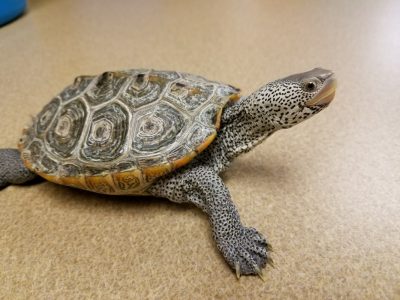
Figure 1. Many pet turtle and tortoise patients are fairly calm patients. Photo credit: Erica Mede, CVT Click image to enlarge.
SHELL
The shell is an unusually strong and durable structure that provides variable degrees of protection (Fig 2). Fingers can become trapped when the functional hinge closes at the front, back (or both) of the plastron or carapace (lower and upper shell respectively). These hinges are present in some species like the box turtle. Fingers can also be trapped against the spurs or pointed shell of the chelonian while they are restrained. The legs can also be powerful enough to pin fingers between the shell and the legs.
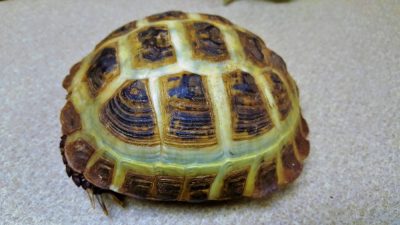
Figure 2. The shell is a strong and durable structure that provides variable degrees of protection. Erica Mede, CVT Click image to enlarge.
BEAK
Chelonians possess no teeth but the beak can be quite strong and sharp. Never reach across a large turtle or tortoise that is not restrained. Chelonians can deliver a very firm bite and demonstrate a reluctance to release. Some aquatic turtles, like the red-eared slider (Trachemys scripta), tend to be more aggressive, and can reach their long neck around the side and bite the handler. Use particular caution with freshwater snapping turtles as they can inflict particularly deep, powerful bites (Fig 3, Fig 4).
CLINICAL TIP: Use a tongue depressor, rubber spatula, or some other large flat object to serve as a “beak blocker”.
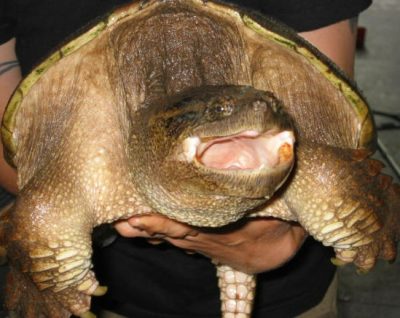
Figure 3. Snapping turtles can inflict deep, painful bites. Photo credit: Ontario Turtle Conservation Centre Click image to enlarge.
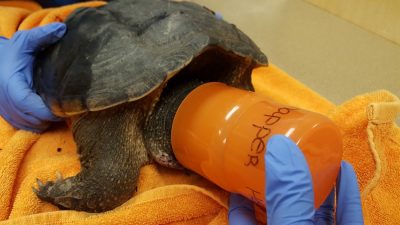
Figure 4. A cup placed over the head can be used as a makeshift ‘muzzle’ for brief diagnostic or therapeutic procedures in this small snapping turtle. Photo credit: Erica Mede, CVT Click image to enlarge.
Visit The Snapping Turtle – Tips for the Practitioner for recommendations on safe handling and restraint techniques.
NAILS
The nails of some chelonians like aquatic turtles can inflict painful scratches (Fig 5).

Figure 5. Aquatic turtles, like this red-tailed slider (Trachemys scripta), often have long, sharp nails that can inflict painful scratches. Photo credit: Erica Mede, CVT Click image to enlarge.
CLINICAL TIP: Try trimming the toenails in species with long, claw-like nails—although this may not help considerably.
URINE
An agitated or frightened chelonian will often urinate on the handler as it is picked up.
Capture and handling
Most small to medium-sized chelonians are easily held by the shell with both hands (Fig 6). More aggressive species, like aquatic turtles, should be held at or closer to the rear of the carapace. To minimize the risk of zoonotic exposure, wear disposable gloves whenever possible and always wash hands thoroughly after handling the reptile.
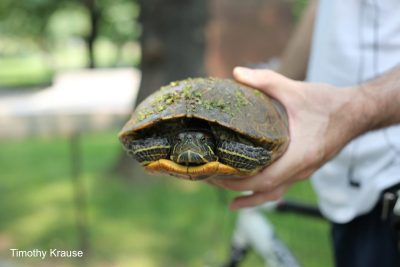
Figure 6. Most small or medium-sized turtles can be held between the front and rear legs at the end or side of the carapace, much as one would a burger. Note: Ideally, this turtle should be held in both hands and disposable gloves should be worn. Photo credit: Timothy Krause via Flickr Creative Commons Click image to enlarge.
The normal, healthy chelonian should resist restraint and a hallmark of good health is a patient that attempts to escape.
CLINICAL TIP: To keep your chelonian patient in one place, simply lift all four feet off of the ground with a bowl or towel (Fig 7).
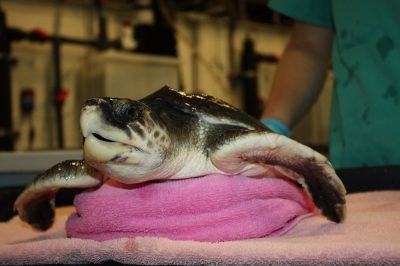
Figure 7. Placing a bowl, or in this case a rolled towel, beneath the lower shell or plastron, can lift all four feet off the ground, thereby keeping your patient in one place. Shown here, a Kemp’s ridley sea turtle (Lepidochelys kempii) at the New England Aquarium. Photo credit: New England Aquarium via USFWS Flickr Creative Commons. Click image to enlarge.
Visit Sea Turtle Restraint for recommendations on safe handling and restraint techniques.
Restraint techniques
Although chelonians are usually the easiest reptile to capture, they can be the most challenging patients to restrain. Healthy chelonians are strong and even debilitated patients can be extremely uncooperative, particularly large tortoises (e.g. Testudo spp.) and box turtles. Restraint techniques can vary between small and large chelonians. Individuals and species can vary dramatically in size and strength, however always take care not to be too forceful during restraint. Instead apply steady yet gentle traction. Most small to medium-sized chelonians will eventually tire and allow the handler to extend the body part of interest. Limb fractures can occur with rough handling, particularly in individuals suffering from nutritional secondary hyperparathyroidism or “metabolic bone disease” (Divers 2015).
Gaining control of the head
Often the most difficult part of the chelonian examination is coaxing the animal from its shell. The turtle neck has an S-shaped curve that allows the animal to withdraw the head into the shell. There are several ways to gain control of the head.
Option 1
First, it may be possible to simply grasp the head of a small, debilitated chelonian firmly behind the mandibles (Fig 8). Approach the turtle’s head from behind or underneath to prevent the turtle from noticing the imminent restraint. Apply firm, gentle traction until the animal’s resistance is overcome and the head can be extended.
CLINICAL TIP: While restraining the head, avoid placing dorsoventral pressure with your fingers as this can damage the soft tissues of the neck and trachea.

Figure 8. Firmly grasp the head behind the mandibles. Photo credit: Erica Mede, CVT Click image to enlarge.
Option 2
Patience is often a critical tool in chelonian restraint. Pair your patience with the animal’s natural curiosity. It can also help to speak quietly and avoid any sudden movements. When set down on the exam table, the turtle or tortoise may begin to explore. It may then be possible to simply grasp the head with one hand while restraining the body with the other hand.
CLINICAL TIP: Many turtles will quickly withdraw the head when approached from the top. Approach the head from underneath or behind whenever possible.
Option 3
Tipping the patient forward, so the head is held down, will sometimes persuade a shy individual to protrude its head out of the shell (Divers 2015, Nugent-Deal 2011, Bradley 2002).
Option 4
Touching or pressing the rear limbs can stimulate a turtle or tortoise to extend the head or forelimbs for quick capture.
Option 5
Another technique described is to place the chelonian in a container of shallow, warm water. Most turtles or tortoises will attempt to get out of the container and extend their heads in the process (Nugent-Deal 2011).
Option 6
If the aforementioned techniques fail, it may be possible to insert a small, blunt probe like an ear curette or a spay hook padded with porous tape or elastic wrap, beneath the horny portion of the upper beak or rhinotheca. After placing the probe, it can be gently retracted to extend the neck until the head can be grasped.
Caution: Use of a probe to open the mouth carries risks as the beak can be chipped or even broken if the animal struggles or is in poor health.
To maintain control of the head, place an index or middle finger on one side of the skull behind the occipital condyles, and your thumb on the other side of the head. The other fingers of that hand can be placed along the neck just behind the base of the skull. Steady, distractive pressure to the maxilla and mandible can be used to open the mouth, or an oral speculum can be gently, yet firmly inserted. Once the mouth is open, the index finger (in very small, gentle specimens) or a mouth gag (in most chelonians) can be inserted into the mouth to prevent closure (Fig 9, Fig 10) (Divers 2015). If the animal is extremely active, a second person may be needed to restrain the body.
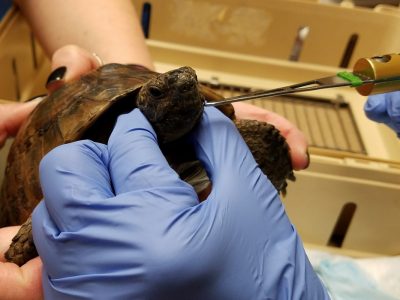
Figure 9. An oral speculum is gently inserted at the commissure of the mouth of this Greek tortoise (Testudo graeca complex). Photo credit: Erica Mede, CVT Click image to enlarge.
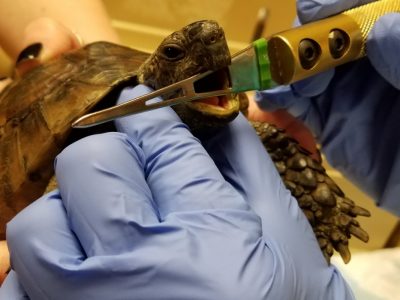
Figure 10. An oral speculum is used to perform a complete oral examination. Photo credit: Erica Mede, CVT Click image to enlarge.
Box turtles
Box turtles are one of the most challenging chelonians to properly restrain because there is a hinge on their plastron, making the shell almost completely impenetrable (Fig 11). One method to extend and gain control of the box turtle’s head is to gently, and with great care, pry open the cranial portion of the shell with a well-padded object like a tongue depressor or smooth, stainless steel speculum. Then a padded wedge or mouth gag, can be used to prevent complete closure of the hinge. Once a leg can be extended, the head can be grasped as no chelonian will close a hinge on its own extended limb.
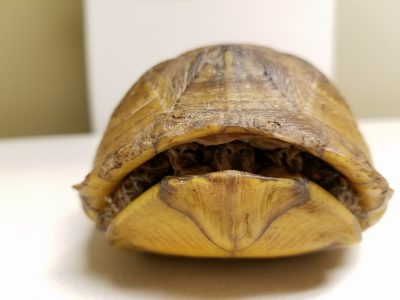
Figure 11. A box turtle can move the cranial part of the plastron upward, making the shell almost impenetrable. Shown here, a three-toed box turtle (Terrapene carolina triunguis). Photo credit: Erica Mede, CVT Click image to enlarge.
Sedation
Capture and restraint can be stressful for the turtle or tortoise patient. If initial attempts are not successful, sedation or general anesthesia may be necessary, particularly for large, strong tortoises. Preventing a large tortoise from pulling free can be physically impossible.
Conclusion
Diagnostic and therapeutic procedures cannot be administered until you and your staff can safely handle and restrain the turtle or tortoise patient. Many chelonian patients presented to the veterinary hospital are ill and therefore their temperament and strength level can be reduced. Normal, healthy chelonians tend to be bright, alert and very strong, making them extremely challenging to restrain. Gaining control of the head can be particularly difficult, however multiple techniques have been described. To prevent injury to your patient, it is important not to apply too much force. At the same time, the handler must protect themselves. Chelonians possess several defense mechanisms, including the protective shell and a strong, sharp beak. Aquatic turtles are more likely to attempt to bite.
References and further reading
References
Bays TB. Handling and restraint and venipuncture of exotic animals. Proc Annu Conf 65th Convention Canadian Vet Med Assoc; 2013.
Bradley TA. Basic reptile handling and restraint. Proc Annu Western Veterinary Conference 2002.
Cannon M, Johnson R. Handling and nursing reptiles (What’s normal & what’s not). Proc NSW Division Regional Conference 2014.
Divers SJ. Clinical approach to tortoises and turtles. Proc ExoticsCon Main Conference 2015:543-544.
Eatwell K. The reptile consultation. Proc Annu British Small Animal Veterinary Congress 2013.
Nugent-Deal J. Reptile physical exam, capture, restraint and venipuncture Techniques. Proc Annu Conf Amer Board of Veterinary Practitioners 2011.
Further reading
Ballard B, Cheek R (eds). Exotic Animal Medicine for the Veterinary Technician, 3rd ed. Ames, IA: Wiley Blackwell; 2017.
Bassert JM, Thomas J. McCurnin’s Clinical Textbook for Veterinary Technicians. St. Louis: Elsevier Health Sciences; 2017.
Centers for Disease Control. Take care with pet reptiles and amphibians. Centers for Disease Control Web site. April 3, 2017. Available at https://www.cdc.gov/features/salmonellafrogturtle/index.html. Accessed September 28, 2017.
Johnson R. Serious reptile practice – How to tame a tiger snake, and more. Proc Annu Conf Australian Veterinary Association 2013
Mader D. Reptile handling and husbandry. Proc Annu Western Veterinary Conference 2009
Mitchell MA. Managing the reptile patient in the veterinary hospital: Establishing a standards of care model for nontraditional species. J Exotic Pet Med. 19(1):56-72, 2010.
Pollock C, Arbona N. Chelonian handling and restraint. Sep 28, 2017. LafeberVet Web site. Available at https://lafeber.com/vet/chelonian-handling-and-restraint/